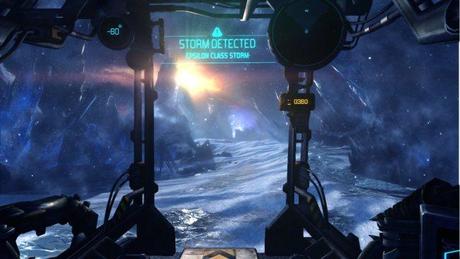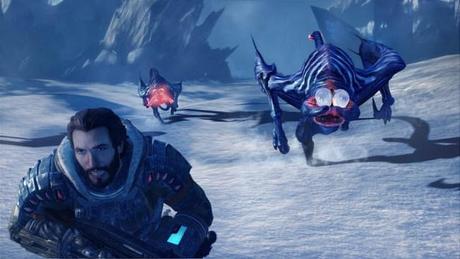Originally this review was meant to go up on GameRanx but, because of various reasons – mainly the postman – it ended up being done too late for the site. As I already had it written up, it felt like a waste to not publish it, so here it is. I hope you enjoy reading it, the two people who do!

The latest in Capcom’s outsourcing of established franchises, Lost Planet 3 is the best game Spark Unlimited have ever made. That’s faint praise, really – considering their track record – but Lost Planet 3 isn’t a complete disaster, unlike Legendary: I still get the flashbacks.
Lost Planet 3 is a prequel to the previous games, still taking place on the icy surface of EDN III, but back when it wasn’t just the local fauna – the Akrid – that wanted you dead. This time, even the weather wants to kill you. Not that you can die by the weather’s frosty tentacles, however – the weather effects are just there for you to gawp at, at specific points of the game. It feels like a missed opportunity.
If the weather was dynamic, and posed a threat to the player, it could have opened up some interesting scenarios and added some urgency and vulnerability to the exploration. Currently – although it’s impressive to watch what I like to call ‘mountain crumbs’ raining from the sky – it just feels half baked. It’s an open-world that’s not quite open, and ends up being a set of interconnected glacial corridors that you’re often forced to trudge through… really slowly.
The story is your usual mix of secretly evil corporations and shooting things in their glowy orange bits. What makes the narrative strangely compelling however, is in the characterisation of the main cast. The protagonist, Jim Patton, is an everyman sort with a predisposition for stabbing sentient tulips in the… face?
Of course, his real reason for being at EDN III isn’t Akrid genocide, it’s because he loves his wife. So he left her, and his infant son, for another planet. Harvesting the planet’s energy is good money, see? Jim gets video messages from his wife at regular intervals during the game. These moments paint Jim as a likeable and human hero.

T-Energy is EDN III’s version of Earth’s oil, and it’s Jim’s main task to extract it. Jim’s a utility Rig operator, which means he gets to stomp around in a giant anthropomorphic machine, fixing burst pipes – no, really – and ripping giant crab’s arms off. Inside the mech, the perspective – which is usually third-person – switches to first-person. The Rig isn’t weaponised in a traditional sense, and you must rely on its drill and claw, giving it the feeling of a multistorey Big Daddy.
Stomping around under icy stalagmites, blue lens flare in your eyes, the machine feels satisfying for a while – using its onboard music player to distract you from its hulking sluggishness. Combat in the Rig is like some sort of strange first-person fighting game with an over reliance on countering, leading to fights played defensively: waiting for your chance to tap block so that you can trigger a QTE.
You can use the drill in close combat, or smash them with your claw arm, but the best results come from counters. One neat touch is in using your grapple – usually reserved for accessing predetermined elevations – to attack ranged enemies.
The best thing about the Rig is when you’re on foot, looking up at it. Human-like in appearance, with eight spotlights framing its chiselled skull, the cockpit. The design is chunky and intimidating, with the machine folding down as you wander up to it. If you leave the music player on, twangy guitars echo from it eerily. Unless you’re wandering around one of the hub areas, where you can chat to people or upgrade your equipment or Rig, you generally come to a bottleneck when stomping along in the Rig, meaning you must continue on foot.
When on foot, as the distance between you and it increase, you lose connection to your machine. This means you lose HUD elements, like your map, when you need them the most. It’s not like the areas are complex, but the planet – and especially enclosed areas, like caves – is made of ice… It all looks pretty similar and its easy to get turned around in battle. This can lead to an extra two loading screens as you leave and re-enter the area. Oh, and all those Akrid you just killed? They’ve reanimated.
Another annoyance rears its head when you’re boxed in: when entering a crawlspace, Jim automatically crouches and it’s impossible to draw your weapons or cancel the animation without crossing an invisible boundary. If you accidentally back into this animation whilst strafe-shooting Akrid, you’ll find yourself defenseless as you’re swarmed. You can take advantage of problems like this, though, entering so the enemies spawn and backing off to a point they can’t reach, picking them off.

Other than these few annoyances, the on foot stuff is inoffensive and functions relatively well as a third-person shooter with a rudimentary cover system. There are a variety of enemies, each requiring different tactics, but the game has a tendency to overuse them once introduced, so they quickly lose their novelty. The guns are all functional, but lack the feedback required to make them feel powerful. One thing that makes up for this is how the enemies react to damage, distracting from the limp weaponry.
You get access to a grapple later on, adding a bit of verticality to select encounters. When up against the series’ staple giant enemies, combat is all about diving out the way at just the last moment so you can expose those genetically fucked up orange weak spots and fire hundreds of rounds into it. If you die during these lengthy encounters, you’ll be hoisted back to the start of the encounter. This in itself is fine, but I really don’t want to watch that unskippable cutscene for the 40th time.
The pacing is really strange, too. A revelation in the plot is followed by the introduction of Platform Mode – a much touted feature when the game was shown at preview stage. Platform Mode is essentially Horde Mode, and its addition adds little to the game, other than padding.
One thing the game does do well is in the atmosphere of EDN III. Although consistently icy, the game still has more vista than Windows. The constant snowfall and the freak storms, coupled with brilliant sound design, help to reinforce the feeling of a hostile and alien planet. It’s beautiful standing on a mountain above the clouds in your Rig, looking out at the other splintered peaks poking through in the distance.
The game isn’t perfect by a long shot, but it certainly isn’t terrible. I’m sure there will be plenty of people who find something to like when they play the game. And I’m sure there will be just as many detractors. I found myself enjoying the game, at times. At others, I was so bored I felt like cheese grating my eyeballs. The occasions when the game’s good unfortunately serve to highlight the myriad inconsistencies, further irritating and distracting from the meat of the game. If you like sci-fi and mechs you’ll probably find a lot to like if you can look past the flaws. [Insert leaving out in the cold pun here].

